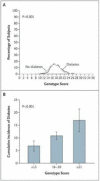Genotype score in addition to common risk factors for prediction of type 2 diabetes
- PMID: 19020323
- PMCID: PMC2746946
- DOI: 10.1056/NEJMoa0804742
Genotype score in addition to common risk factors for prediction of type 2 diabetes
Erratum in
- N Engl J Med. 2009 Feb 5;360(6):648
Abstract
Background: Multiple genetic loci have been convincingly associated with the risk of type 2 diabetes mellitus. We tested the hypothesis that knowledge of these loci allows better prediction of risk than knowledge of common phenotypic risk factors alone.
Methods: We genotyped single-nucleotide polymorphisms (SNPs) at 18 loci associated with diabetes in 2377 participants of the Framingham Offspring Study. We created a genotype score from the number of risk alleles and used logistic regression to generate C statistics indicating the extent to which the genotype score can discriminate the risk of diabetes when used alone and in addition to clinical risk factors.
Results: There were 255 new cases of diabetes during 28 years of follow-up. The mean (+/-SD) genotype score was 17.7+/-2.7 among subjects in whom diabetes developed and 17.1+/-2.6 among those in whom diabetes did not develop (P<0.001). The sex-adjusted odds ratio for diabetes was 1.12 per risk allele (95% confidence interval, 1.07 to 1.17). The C statistic was 0.534 without the genotype score and 0.581 with the score (P=0.01). In a model adjusted for sex and self-reported family history of diabetes, the C statistic was 0.595 without the genotype score and 0.615 with the score (P=0.11). In a model adjusted for age, sex, family history, body-mass index, fasting glucose level, systolic blood pressure, high-density lipoprotein cholesterol level, and triglyceride level, the C statistic was 0.900 without the genotype score and 0.901 with the score (P=0.49). The genotype score resulted in the appropriate risk reclassification of, at most, 4% of the subjects.
Conclusions: A genotype score based on 18 risk alleles predicted new cases of diabetes in the community but provided only a slightly better prediction of risk than knowledge of common risk factors alone.
2008 Massachusetts Medical Society
Figures

Comment in
-
Clinical risk factors, DNA variants, and the development of type 2 diabetes.N Engl J Med. 2009 Mar 26;360(13):1360; author reply 1361. doi: 10.1056/NEJMc082624. N Engl J Med. 2009. PMID: 19321875 No abstract available.
-
GATTACA--are we there yet?Nat Rev Endocrinol. 2009 Apr;5(4):187-8. doi: 10.1038/nrendo.2009.45. Nat Rev Endocrinol. 2009. PMID: 19352313
References
-
- King H, Aubert RE, Herman WH. Global burden of diabetes, 1995-2025: prevalence, numerical estimates, and projections. Diabetes Care. 1998;21:1414–31. - PubMed
-
- Schmidt MI, Duncan BB, Bang H, et al. Identifying individuals at high risk for diabetes: the Atherosclerosis Risk in Communities study. Diabetes Care. 2005;28:2013–8. - PubMed
-
- Stern MP, Williams K, Haffner SM. Identification of persons at high risk for type 2 diabetes mellitus: do we need the oral glucose tolerance test? Ann Intern Med. 2002;136:575–81. - PubMed
-
- Wilson PW, Meigs JB, Sullivan L, Fox CS, Nathan DM, D’Agostino RB., Sr Prediction of incident diabetes mellitus in middle-aged adults: the Framingham Offspring Study. Arch Intern Med. 2007;167:1068–74. - PubMed
Publication types
MeSH terms
Grants and funding
LinkOut - more resources
Full Text Sources
Other Literature Sources
Medical
